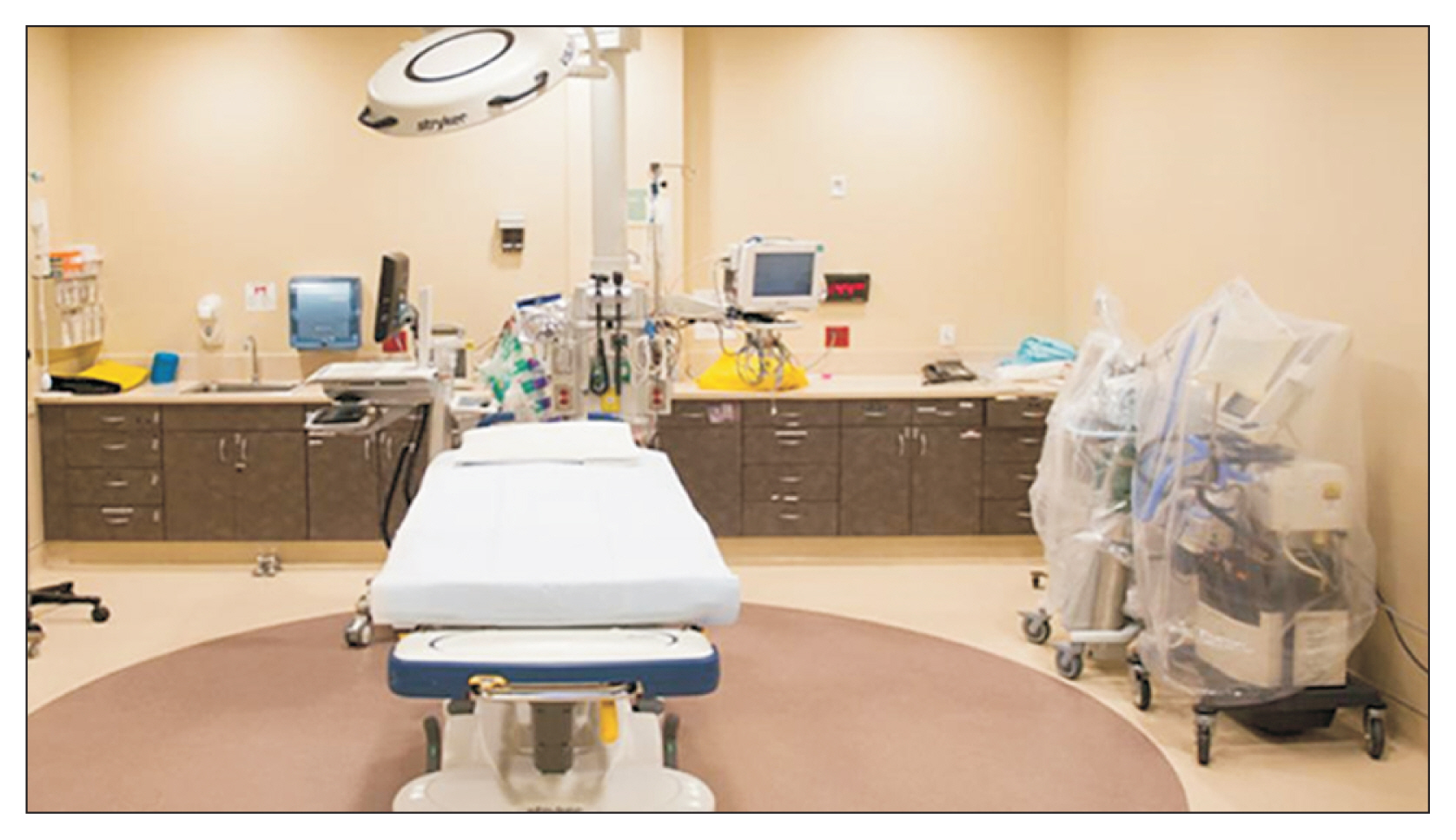 |
 |
- Search
| Healthc Inform Res > Volume 28(4); 2022 > Article |
|
Abstract
Objectives
The purpose of this study was to explore new ways of creating value in the medical field and to derive recommendations for the role of medical institutions and the government.
Methods
In this paper, based on expert discussion, we classified Internet of Things (IoT) technologies into four categories according to the type of information they collect (location, environmental parameters, energy consumption, and biometrics), and investigated examples of application.
Results
Biometric IoT diagnoses diseases accurately and offers appropriate and effective treatment. Environmental parameter measurement plays an important role in accurately identifying and controlling environmental factors that could be harmful to patients. The use of energy measurement and location tracking technology enabled optimal allocation of limited hospital resources and increased the efficiency of energy consumption. The resulting economic value has returned to patients, improving hospitals’ cost-effectiveness.
Conclusions
Introducing IoT-based technology to clinical sites, including medical institutions, will enhance the quality of medical services, increase patient safety, improve management efficiency, and promote patient-centered medical services. Moreover, the IoT is expected to play an active role in the five major tasks of facility hygiene in medical fields, which are all required to deal with the COVID-19 pandemic: social distancing, contact tracking, bed occupancy control, and air quality management. Ultimately, the IoT is expected to serve as a key element for hospitals to perform their original functions more effectively. Continuing investments, deregulation policies, information protection, and IT standardization activities should be carried out more actively for the IoT to fulfill its expectations.
The fourth industrial revolution refers to a series of phenomena in which the rapid development of core technologies such as nanotechnology, artificial intelligence, and the Internet of Things (IoT) brings fundamental changes in various fields such as job creation, education, and industry [1,2]. These developments are expected to inspire essential changes in the overall healthcare system. Hospitals can innovatively and continuously expand from a preventive approach to precision medicine by utilizing various new technologies such as big data, artificial intelligence, robotics, IoT, unmanned transportation, nanotechnology, 3D printing, and genome analysis. These technological advances can also cause social changes. New medical technology has increased the elderly population and raised the need for systematic data establishment to manage and prevent diseases. Social problems caused by modern health issues and changes in health status have triggered demands for high-quality healthcare and its efficient provision [3–5].
“Future hospitals” born from such technological and social changes can establish the automation and standardization of knowledge-based tasks [1]. This will involve methods of connecting the entire medical process based on IoT and sensor technology and increasing operational efficiency with real-time monitoring and feedback functions. Through these innovations, hospitals can aim to provide high-quality, integrated individual medical care on a continuous basis [6]. For example, it will be possible to provide systematic disease management and treatment by utilizing information on the patient’s past disease history or lifestyle, and by reflecting the current state at the same time [7]. In addition, the system will shift to focusing on the quality of care and ensure an appropriate balance between prevention and follow-up treatment. These processes will be done through an automated system that does not waste the time of medical personnel. Currently, with the positive recognition of innovative changes in hospitals, such as the rise of the concept of the “smart hospital” as a form of the “future hospital,” the government and the private sector have been paying attention to these changes [5,8].
In short, the core value of future hospitals is to secure internal and external connectivity, and to improve the effectiveness of patient treatment and enhance experiences by automating and optimizing internal processes [8,9]. The IoT is considered to be the most important technology to actualize this goal. Currently, hospitals are expanding their use of the IoT in various ways, from medical equipment GPS tracking to patient assessment, and its effectiveness has been demonstrated. In particular, the IoT is expected to contribute to realizing the values of improving the quality of medical services, increasing patient safety, improving management efficiency, and serving patient-centered healthcare when it is introduced to clinical sites, including medical institutions [2].
The “Internet of Things” (IoT) is a term coined by entrepreneur Kevin Ashton, who founded the MIT Auto-ID Center. It refers to a network of objects and spaces that form cooperative informational relationships (such as sensing, networking, and information processing) for three distributed environmental elements (humans, things, and services) without human intervention [10,11]. Through IoT technologies, objects can collect and transfer information on their own, minimizing human interventions. Furthermore, information exchange and processing between objects have led to the provision of better services. The structure of IoT technology is broadly classified into four layers: perception, network, middleware, and application. In the perception layer, physical/environmental data, such as temperature, humidity, and light, are collected through various sensors and are then transmitted through the network.
In the network layer, communication technologies, such as the internet, Wi-Fi, and routing, are used to transmit the information collected in the perception layer to a computing device. In the middleware layer, information is interpreted and stored using the network for application programs required for services. Specifically, the middleware layer provides high-performance computing and storage functions and includes information analysis systems such as broker servers, permanent data storage, queuing systems, and machine learning systems. In the application layer, services are grouped by place and purpose, and are combined in various fields (e.g., housing and transportation) to provide services to users [12] (Figure 1).
The formation and expansion of a network using the IoT and the development of IoT-based services can be seen through the following examples. Philips launched a smart lighting system in 2013, and Whirlpool introduced a home IoT-based smart home system involving kitchen appliances. Consumers have responded favorably, reporting that it has reduced their time spent on housework and has enhanced convenience [13,14]. IoT-based services are already driving changes and innovations in various industries.
The establishment of an IoT-centered digital infrastructure is expected to play an essential role in implementing a “future hospital,” which can be defined as a medical institution that improves patient treatment effects and experiences by automating and optimizing internal processes [8,15].
In this paper, we examine the emergence of the IoT and examples of new services that have been implemented in the medical field by applying IoT technology in South Korea and other national communities. Through this, we intend to explore new types of value that can be achieved in the medical field, and to derive suggestions on the role of medical institutions and the government.
Through a documentary survey, we investigated cases of IoT use in the medical service field, and determined the final categorization method by requesting an expert review and by classifying the types of use of the researched cases.
First, we conducted a literature review search of two electronic databases (PubMed and Google) to identify studies published between January 2014 and December 2021. Related references were identified by designating “IoT services” and “classification sensors” as keywords, and data described in papers, reports, newspaper articles, and websites were collected.
Next, we requested that experts review the cases described in the collected literature and present opinions on categorization focusing on the technological elements of IoT services, the sensors used, and the data collected. The final classification was determined by synthesizing the opinions of experts on categorization. When there was a difference of opinion among experts, the final opinion was coordinated through consultation.
A service can track movement paths by measuring the location of people and objects. Inertial sensors such as gyro sensors, acceleration sensors, and geomagnetic sensors are mainly used for this type of tracking service.
As an example of a real-time location tracking service for patient and hospital asset information, the Mount Sinai Hospital has built a real-time location system (RTLS) infrastructure that tracks assets including personnel, monitors appropriate utilization levels, optimizing the productivity of medical staff. The hardware used for RTLS includes asset tags, autoclave tags, temperature monitoring tags, patient tracking tags, locators, transmitters, and receivers. As software, the RTLS uses location tracking applications and reporting applications, which visualize the current monitoring status on a dashboard. The previous system cost about US $1,729 per shift to locate medical devices in 26 wards, but the application of the IoT service has reduced the cost requirement for managing patient and hospital assets by about US $1.26 million per year. At Aventura Hospital in Florida, USA, hospitalization time was reduced by 3,000 hours over 9 months by using the RTLS technology, which allowed the hospital to operate more than 400 additional rooms. Thus, the RTLS was able to achieve efficiency in asset management and personnel input, enabling medical services to be provided in a timely manner for positive patient experiences [2,16,17].
Yongin Severance Hospital has been seeking to transform into a smart hospital by establishing a digital component of the hospital through the involvement of medical IT experts, biomedical engineering experts, and statistics experts. In the event of an infection or emergency, location information can be monitored in the hospital’s Integration & Response Space through an infection tracking RTLS solution. This system was able to overcome the limitations of existing infection tracking, which previously relied only on oral reports and CCTVs. Furthermore, movement routes of hospital workers, patients, and caregivers and density in the hospital could be identified based on real-time monitoring of location information, allowing the hospital to predict the time and place of overcrowding and implement preemptive responses [17] (Figure 2).
Sana Klinikum, a German medical corporation, adopted a real-time bed location identification system using Simplinic GmbH, an IoT cloud solution. Using beds equipped with pressure sensors from Stiegelmeyer, the system collects information about the occupancy and location of individual beds in medical institutions. By measuring the patient’s body pressure on the bed and transmitting a bed occupancy signal through Bluetooth, information on the occupancy and location of each bed can be obtained. This automated process has shortened the time required to search for beds, thereby reducing the burden on medical personnel [18] (Figure 3).
Monitoring pollutants and pathogens through IoT temperature, humidity, air quality, water quality, soil moisture, and UV sensors helps to provide patients with a more pleasant and safe environment.
Hazel Hawkins Memorial Hospital in the United States uses temperature and humidity sensors to maintain a sterile environment in operating rooms. In operating rooms, an appropriate temperature of 18°C–24°C and an appropriate humidity of 50%–55% should be maintained to prevent the growth of microorganisms, and to maintain body temperature to obviate the risk of infection during surgery. In the past, such information was manually recorded to maintain proper temperature and humidity conditions. However, temperature and humidity records were missing during periods when there were no scheduled operations, making it impossible to generate continuous data. To compensate for this shortcoming, monitoring sensors and wireless environmental sensors were deployed to collect data on humidity, temperature, positive pressure, and refrigerator temperature for 24 hours a day. This system has made it possible to create an ideal operating room environment, where the growth of microorganisms is inhibited and electrostatic discharge is prevented [19] (Figure 4).
Soonchunhyang University Bucheon Hospital adopted a smart indoor air quality improvement service (known as the “SMART IoT Good Air Service”) that measures and intensively controls indoor air quality. Real-time IoT environmental sensors collect and transmit measurement data on indoor air pollutants such as ultrafine dust, fine dust, volatile harmful substances, and carbon dioxide, and on outdoor air pollutants such as ozone, carbon monoxide, nitrogen dioxide, and sulfur dioxide. The results are presented to visitors as graphs in real-time. By applying air quality monitoring sensors to medical services and managing the air quality of the respiratory allergy center ward, the hospital provides a safe and comfortable treatment space to patients with respiratory and lung diseases [20,21] (Figure 5).
Monitoring the use of gas, water, and sewage makes it possible to implement a service to use finite resources more efficiently. Sensors such as pressure, gas, and flow are mainly used for energy monitoring.
At Royal Adelaide Hospital in Australia, an IoT system was introduced to efficiently manage the energy consumed within 24-hour periods to provide medical services such as the management of medical devices, lighting, and the operation of ventilation systems. The hospital collects energy consumption information measured from various IoT devices such as temperature sensors, power meters, circuit breakers, and uninterruptible power supply devices. The collected information is transmitted to the analysis/control system to analyze energy usage patterns. The analyzed data are used to manage the amount of energy consumption and improve the efficiency of energy consumption. The system has reduced hospital operating costs, and the saved costs are used to improve the treatment environment, eventually leading to improvements in the medical services provided by the hospital [22].
Catholic Kwandong University International St. Mary’s Hospital has been using various IoT technologies to reduce energy consumption in hospitals. To reduce energy consumption, which amounts to about 2.5 times that of a university (30 kilograms of oil equivalent [kgoe]/m2) and 1.7 times that of a large company (43 kgoe/m2), the hospital introduced IoT services to measure energy consumption and environmental variables. By collecting environmental and energy data in real-time through temperature and humidity IoT sensors in operating rooms, emergency rooms, and intensive care units, where environmental management is important, appropriate responses can be made if abnormal signs are detected. Smart plugs manage the energy usage of medical devices that consume a lot of power (e.g., magnetic resonance imaging and computed tomography devices), and consumption-related data from the plug-in wireless communication module are transmitted to the server to analyze energy use [23,24].
There is a wide variety of biometric sensors that measure pressure at various places in the human body, bio-motion, and bio-electromagnetics. These sensors provide patients with services that monitor vital signs.
The Smart Health Service frequently measures the blood glucose levels of patients with diabetes to prevent acute changes in the glucose level. Most existing blood glucose measurement methods are based on direct measurements of the blood glucose concentration in a blood sample. The existing measurement methods using blood samples cause physical and psychological pain to patients due to the need for regular examinations. These methods also place a burden on medical service providers in terms of workload and risk of infection exposure. To preclude medical staff ‘s risk of infection caused by repeated blood glucose measurements in patients with diabetes and to ensure work efficiency, Montefiore Medical Center in the United States introduced real-time blood glucose meters that provide data obtained from a blood glucose measurement sensor. A real-time blood glucose meter is a device that can continuously measure blood glucose levels after a sensor is inserted once. The hospital offered this option to patients who needed to control their blood glucose levels after being admitted to the intensive care unit due to coronavirus disease 2019 (COVID-19) infections. The use of the real-time blood glucose meter reduced the number of point-of-care examinations by up to 60% among patients who were prescribed continuous insulin infusions, when compared to the use of an invasive blood glucose meter [25–27] (Figure 6).
Veterans Health Service Medical Center, a medical institution dedicated to the COVID-19 response, created a medical environment for effective responses to infectious diseases by utilizing IoT technology for bio-signal measurements. A monitoring and response system using a wearable device sensor was used to measure bio-signals such as the patient’s body temperature, pulse, blood pressure, and oxygen saturation. By minimizing the frequency of contacts between patients and the medical staff, this system could reduce the risk of infection and enable patients’ conditions to be monitored in real-time. If a patient was determined to be at high risk, this information was transmitted to medical staff to facilitate a prompt response. This system also reduced the number of simple repetitive tasks, such as measuring body temperature and blood pressure, thereby improving the work environment and treatment efficiency [28,29] (Figure 7).
This study examined IoT technologies applied in medical institutions by dividing them into four categories according to the type of information collected: location tracking, environmental parameters, energy consumption, and biometrics.
The use of IoT sensor technology for location tracking will provide timely medical services through the efficient management of medical devices and personnel in hospitals. As a result, patients will be more likely to have positive experiences of medical services.
IoT technology for measuring environmental parameters will play a crucial role in accurately identifying and controlling environmental factors that can be harmful to patients. This technology can help to provide a more pleasant and safe environment to patients by measuring not only temperature, humidity, and air quality, which constitute the indoor hospital environment, but also pollutants, pathogens, and radiation.
The use of IoT sensor technology for energy measurement will optimize the allocation and utilization of limited resources in the hospital and improve the efficiency of energy consumption, thereby enhancing managerial efficiency and reducing hospital costs. The economic value generated from these improvements can be returned to patients, increasing hospitals’ cost-effectiveness.
Biometric IoT technology will improve the quality of medical services provided by hospitals by contributing to medical staff ‘s efforts to accurately diagnose diseases and to provide appropriate and effective treatment. This technology will also increase the accuracy of diagnosis and treatment by monitoring patients’ vital signs in real-time with sensors, and help to identify effective measures for disease management by obtaining information on patients’ daily life conditions, which are difficult to assess in common clinical settings.
As the global pandemic of COVID-19 continues for several years, infection control has become an important social issue. In particular, the IoT sensing technology described above can be practically applied to the five major tasks of facility hygiene, social distancing, contact tracking, bed occupancy control, and air quality management to prevent the spread of infectious diseases. Biometric sensors enable continuous monitoring of patients’ biometric information. Tracking sensors will be used to efficiently allocate patients and medical resources in order to minimize the shortage of medical personnel, to identify infection routes and contacts of confirmed infectious diseases, and to maintain and manage social distancing. This approach is expected to contribute to cost reduction by providing an appropriate environment to prevent exposure to pollutants and pathogen infection by using environmental sensors, and by increasing energy use efficiency through the use of energy sensors. In addition, various methods of utilizing the IoT have been announced in response to the pandemic, and their importance in clinical practice is being further emphasized [30].
It is certain that these IoT-based technologies will contribute to realizing the values of improving the quality of medical services, increasing patient safety, improving management efficiency, and providing patient-centered medical services.
In order for medical institutions to provide new medical services enabled by the integration of IoT technologies, the following efforts are needed.
When designing hospital IoT services, medical institutions should establish information protection measures by complying with cybersecurity regulations and protecting health management records. The Ministry of Food and Drug Safety has released the “Cybersecurity Permit and Review Guidelines for Medical Devices” to encourage compliance with security requirements. The guidelines classify security requirements into the categories of “identify,” “protect,” “detect,” “respond,” and “recover,” and describe each requirement in detail. Medical institutions should promptly apply the security requirements specified in the guidelines not only to medical devices, but also to IoT devices used in institutions and other related services [31,32].
The government needs to establish continuing investment and deregulation policies for hospitals to introduce IoT infrastructure. It is known that it takes more than a year from system planning to installation and construction to implement medical IoT services [31]. Therefore, direct and indirect incentives, such as infrastructure support and appropriation of related medical fees, should be provided to encourage hospitals to build IoT infrastructure. In addition, it is necessary to lay the foundation for research and development of more practical services under legal protection by actively utilizing the regulatory sandbox system.
The government started a project to support the development of a leading smart hospital model to demonstrate hospitals’ IoT services. The results of this project will make it possible to identify areas that require support.
Simultaneously, to encourage the spread of hospital IoT services, standardization activities should be carried out jointly by the government, industry, academia, research institutions, and hospitals. It is necessary to derive an agreed-upon method for connecting various entities and components such as devices, contents, data transmission formats, terminology, and external service interworking. Efforts should also be made to determine the optimal method by integrating multiple guidelines.
Hospitals prioritize the diagnosis and treatment of patients, as well as disease prevention and rehabilitation services. Since the concept of the modern hospital was introduced at the end of the 19th century, hospitals have been evolving and making continuous efforts for the health and well-being of patients, and today, the pace is accelerating due to dazzling advances in science and technology. IoT technologies will further accelerate the development of hospitals by improving connection and accessibility among various entities and by expanding communication in the medical environment. Therefore, it is expected that IoT technologies will become a key element in supporting hospitals to perform their original functions more faithfully.
This study is an exploratory study on IoT services that can be utilized in medical institutions. As technology advances, various technologies and applications can be found. Therefore, continuous expert review and structured case studies are necessary.
Acknowledgments
This research is partly based on the KOSMI Issue Report (2021), which was supported by the Ministry of Health and Welfare, Republic of Korea. And the Technology Innovation Program (No. 20011878, Development of Diagnostic Medical Devices with Artificial Intelligence Based Image Analysis Technology) funded By the Ministry of Trade, Industry & Energy (MOTIE, Korea), and a grant of “2022 Smart Hospital Project” through the Korea Health Industry Development Institute(KHIDI), funded by the Ministry of Health & welfare, Republic of Korea.
Figure 1
Using Internet of Things (IoT) in medical institutions. This picture has been designed using resources from https://www.flaticon.com/. EKG: electrocardiogram, EEG: electroencephalogram, API: application programming interface.
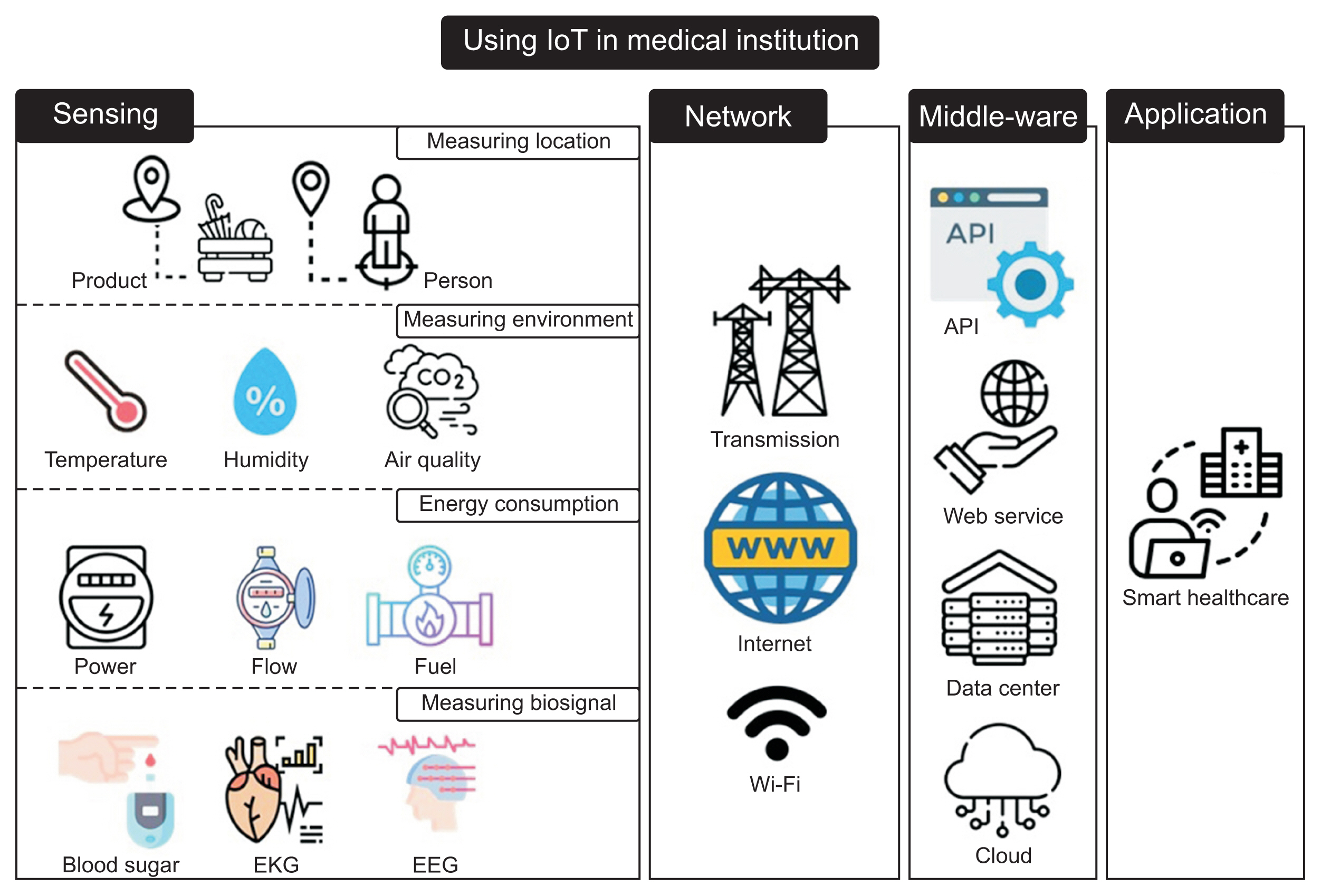
Figure 2
Real-time location system (A) and inpatient BLE tag (B) of Yongin Severance Hospital. Adapted from Medical Observer News [17].
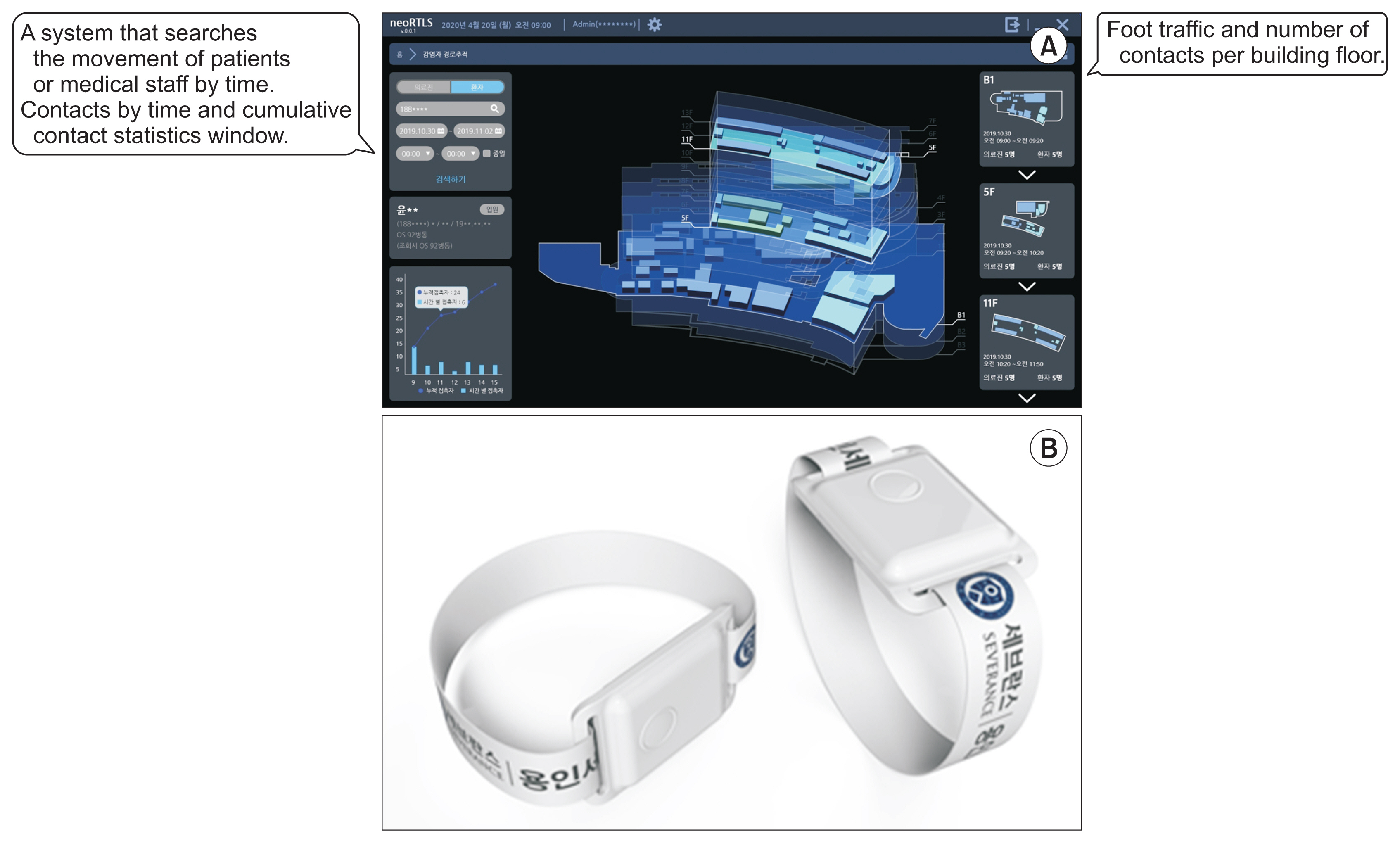
Figure 3
Real-time localization using smart bed from Simplinic GmbH. Adapted from Medical Magazine [18].

Figure 5
Smart indoor air quality improvement service screen at Soonchunhyang University Bucheon Hospital. Adapted from the Korean Hospital Association [20].
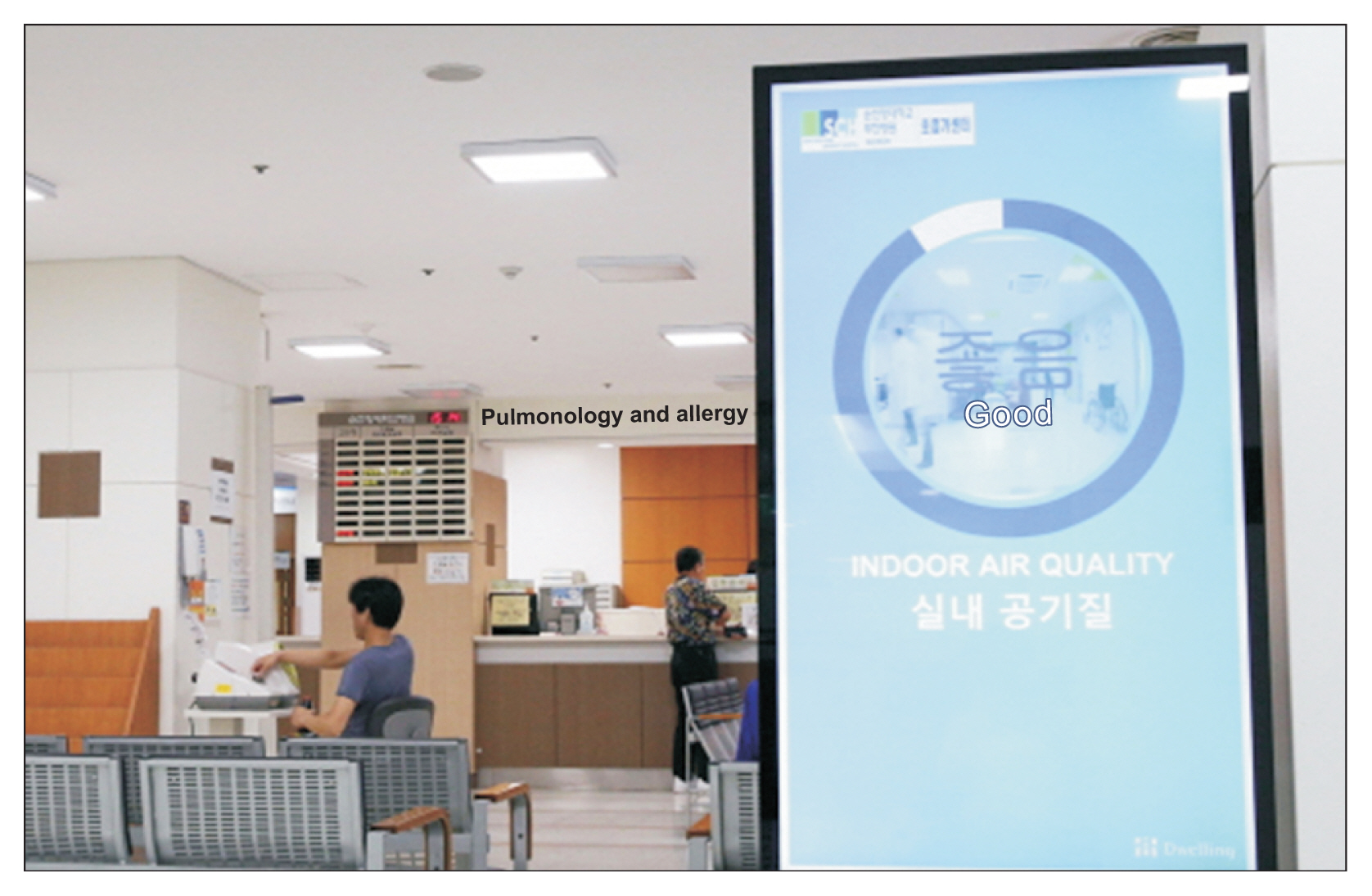
Figure 6
User interface of a continuous blood glucose monitoring sensor and its principles. Adapted from Abbott Laboratory Ltd. [26].
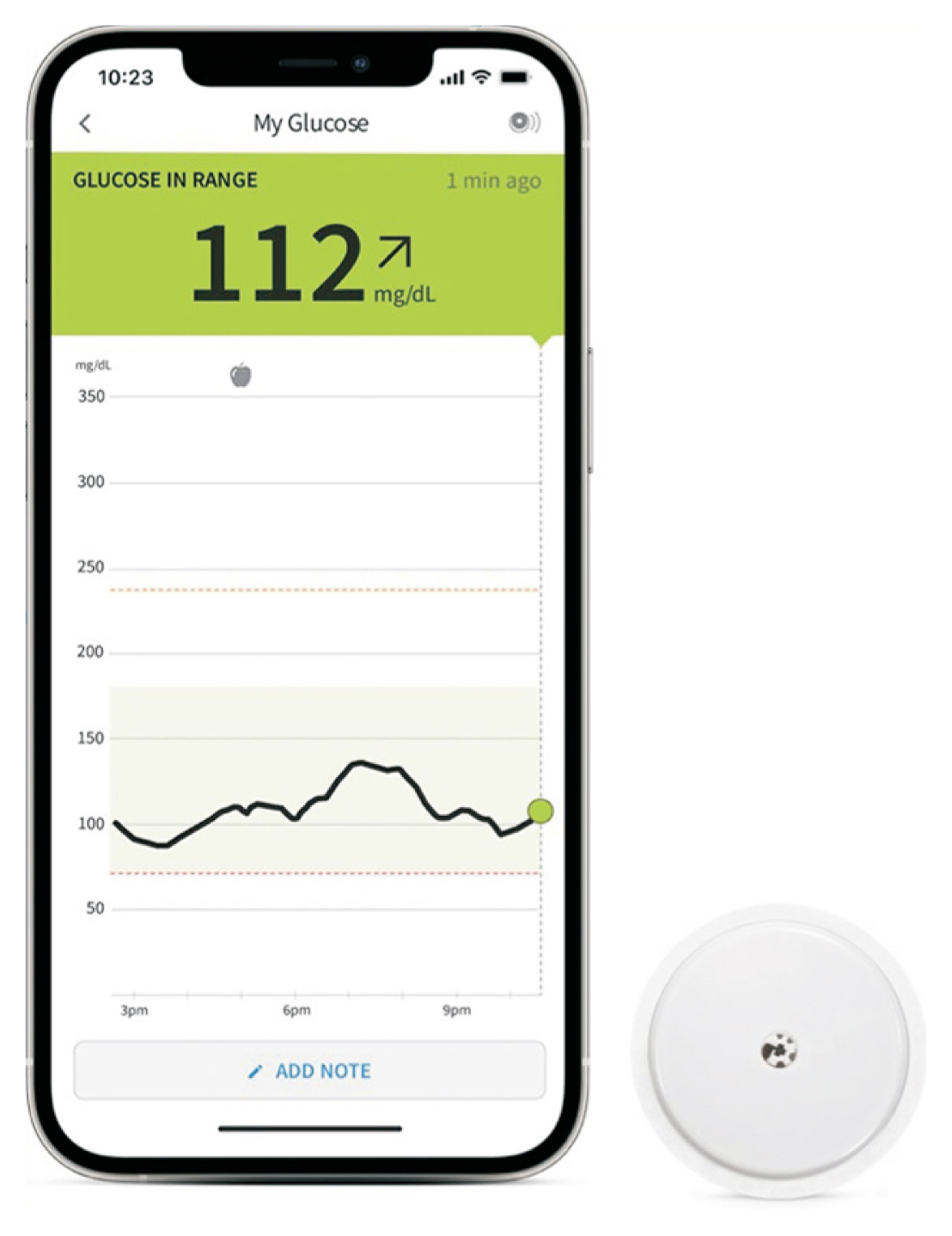
Figure 7
Coronavirus disease 2019 (COVID-19) response service using biometric sensors. Adapted from Jamil F, et al. Sensors 2020;20(8):2195 [29]. EMG: electromyogram, ECG: electrocardiogram, SpO2: oxygen saturation, IoT: Internet of Things, EHR: Electronic Health Record.
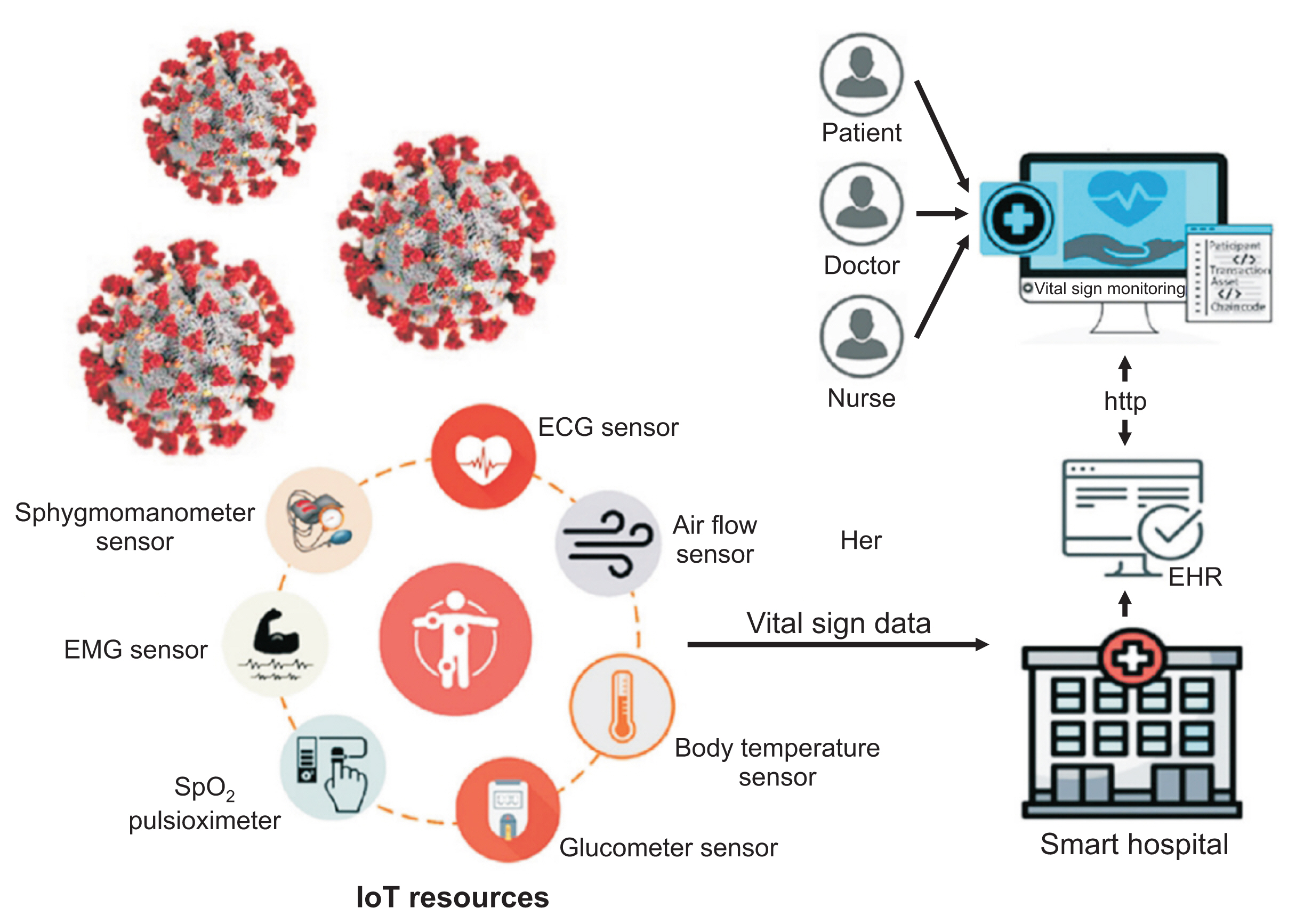
References
1. Shin Y, Lee J, Kim B, Lee J, Lee Y, Hwang D, et al. A plan to reorganize the health care system in accordance with the 4th Industrial Revolution. Sejong, Korea: Korea Institute for Health and Social Affairs; 2017.

2. Pediredla K. This is how your local hospital is using IoT [Internet]. Newcastle upon. Tyne, UK: hedgehog lab; c2021 [cited at 2022 Oct 29]. Available from: https://hedgehoglab.com/blog/this-is-how-your-local-hospital-is-using-iot

3. Akkas MA, Sokullu R, Cetin HE. Healthcare and patient monitoring using IoT. Internet of Things 2020 11:100173.
https://doi.org/10.1016/j.iot.2020.100173

4. Neagu G, Preda S, Stanciu A, Florian V. A cloud-IoT based sensing service for health monitoring. Proceedings of 2017 E-Health and Bioengineering Conference (EHB); 2017 Jun 22–24. Sinaia, Romania; p. 53-6.
https://doi.org/10.1109/EHB.2017.7995359

5. Hussain A, Mehmood A, Arslan F, Nawaz S, Ijaz A, Ali M. Transformative effects of IoT towards smart medical: Internet of Medical Things (IoMT) & Internet of Healthcare Things (IoHT). Int J Emerg Technol 2021;12(2):60-5.

6. Rathore MM, Ahmad A, Paul A, Wan J, Zhang D. Real-time medical emergency response system: exploiting IoT and big data for public health. J Med Syst 2016 40(12):1-10.
https://doi.org/10.1007/s10916-016-0647-6


7. Srinivas M, Durgaprasadarao P, Raj VN. Intelligent medicine box for medication management using IoT. Proceedings of 2018, 2nd International Conference on Inventive Systems and Control (ICISC); 2018 Jan 19–20. Coimbatore, India; p. 32-4.
https://doi.org/10.1109/ICISC.2018.8399097

8. Park J. Smart hospitals are in high demand…The key is people, not technology [Internet]. Seoul, Korea: Daily Medi; 2021 [cited at 2022 Oct 29]. Available from: http://www.dailymedi.com/detail.php?number=873597

9. Yang CT, Chen ST, Den W, Wang YT, Kristiani E. Implementation of an intelligent indoor environmental monitoring and management system in cloud. Future Gener Comput Syst 2019 96:731-49.
https://doi.org/10.1016/j.future.2018.02.041

10. National Science & Technology Information Service. IoT and security [Internet]. Daejeon, Korea: National Science & Technology Information Service; c2015 [cited at 2022 Oct 29]. Available from: http://www.ntis.go.kr/issuernd/main/issueDtl.do?searchTopicNo=201503100002

11. Islam M, Rahaman A. Development of smart healthcare monitoring system in IoT environment. SN Comput Sci 2020 1:185.
https://doi.org/10.1007/s42979-020-00195-y



12. IoT Standards Laboratory. Trends in Internet of Things technology [Internet]. Daegu, Korea: IoT Standards Laboratory; 2020 [cited at 2022 Oct 29]. Available from: https://protocol.knu.ac.kr/tech/ISL-TR-20-05-IoT.pdf

13. Signify Korea. Curious about Philips Hue: connected via Bluetooth without a Bridge device [Internet]. Seoul, Korea: Signify Korea; c2019 [cited at 2022 Oct 29]. Available from: https://blog.signifykorea.com/?p=5556

14. Lee SH, Lee DW. A study on Internet of Things in IT convergence period. J Digit Convergence 2014 12(7):267-72.
https://doi.org/10.14400/JDC.2014.12.7.267

15. Neyja M, Mumtaz S, Huq KM, Busari SA, Rodriguez J, Zhou Z. An IoT-based e-health monitoring system using ECG signal. Proceedings of 2017 IEEE Global Communications Conference (GLOBECOM); 2017 Dec 4–8. Singapore; p. 1-6.
https://doi.org/10.1109/GLOCOM.2017.8255023

16. HIMSS. Implementation of an optimized real time location system at Mount Sinai Hospital & Healthcare RTLS best practices [Internet]. Chicage (IL): DocPlayer; 2016 [cited at 2022 Oct 29]. Available from: https://docplayer.net/12684817-Implementation-of-an-optimized-real-time-location-system-atmount-sinai-hospital-healthcare-rtls-best-practices.html

17. Jeong YS. Development of location information-based infection tracking and management solutions at the center of attention [Internet]. Seoul, Korea: Medical Observer; 2020 [cited at 2022 Oct 29]. Available from: http://www.monews.co.kr/news/articleView.html?idxno=210087

18. Molinari K. Easing the burden on healthcare personnel: bed sensors facilitate fast location of available hospital beds [Internet]. Dusseldorf, Germany: MEDICA Magazine; 2021 [cited at 2022 Oct 29]. Available from: https://www.medica-tradefair.com/en/News/Interviews/Previous_Interviews/Interviews_2021/Easing_the_burden_on_healthcare_personnel_bed_sensors_facilitate_fast_location_of_available_hospital_beds

19. Vaisala. Hospital environmental monitoring: compliant & continuous [Internet]. Vantaa, Finland: Vaisala; 2020 [cited at 2022 Oct 29]. Available from: https://www.vaisala.com/en/case/hospital-environmental-monitoring-compliant-continuous

20. Kim M. Provision of smart indoor air quality improvement services [Internet]. Seoul, Korea: Korean Hospital Association News; 2016 [cited at 2022 Oct 29]. Available from: http://www.khanews.com/news/articleView.html?idxno=123709

21. Lee Y. Soonchunhyang University Bucheon Hospital takes the first steps towards developing the Respiratory Allergy Center [Internet]. Seoul, Korea: Doctors News; 2017 [cited at 2022 Oct 29]. Available from: http://www.doctorsnews.co.kr/news/articleView.html?idxno=114863

22. Opray M. Sensors, plants and waste heat: Adelaide hospital’s bid to be most energy-efficient [Internet]. London, UK: The Guardian; 2017 [cited at 2022 Oct 29]. Available from: https://www.theguardian.com/sustainable-business/2017/jun/05/sensors-plants-waste-heat-adelaide-hospitals-bid-to-be-most-energy-efficient

23. Yoon HY. Real-time temperature and humidity measurement with state-of-the-art sensors, saving electric power consumption [Internet]. Seoul, Korea: JoongAng Sunday; 2016 [cited at 2022 Oct 29]. Available from: https://www.joongang.co.kr/article/21014197#home

24. Shin H. International St. Mary’s Hospital established an energy management system for hospitals: optimized energy utilization [Internet]. Seoul, Korea: Electronic Times; 2016 [cited at 2022 Oct 29]. Available from: https://m.etnews.com/20161228000253?obj=Tzo4OiJzdGRDbGFzcyI6Mjp7czo3OiJyZWZlcmVyIjtOO3M6NzoiZm9yd2FyZCI7czoxMzoid2ViIHRvIG1vYmlsZSI7fQ%3D%3D

25. Agarwal S, Mathew J, Davis GM, Shephardson A, Levine A, Louard R, et al. Continuous glucose monitoring in the intensive care unit during the COVID-19 pandemic. Diabetes Care 2021 44(3):847-9.
https://doi.org/10.2337/dc20-2219



26. FreeStyle Libre. Know how to take the mystery out of your glucose levels [Internet]. Abbott Park (IL): Abbott Laboratories Ltd; c2022 [cited at 2022 Oct 29]. Available from: https://www.freestylelibre.co.uk/libre/discover/discover-now-you-know.html

27. Kim J. How to use a continuous blood glucose meter [Internet]. Seoul, Korea: Samsung Medical Center; 2020 [cited at 2022 Oct 29]. Available from: http://www.samsunghospital.com/webzine/smcdmedu/310/webzine_310_1.html

28. Lee SD. Veterans Health Service Medical Center, treating COVID-19 patients in a smart medical environment [Internet]. Seoul, Korea: Medical News; 2021 [cited at 2022 Oct 29]. Available from: http://www.bosa.co.kr/news/articleView.html?idxno=2143822

29. Jamil F, Ahmad S, Iqbal N, Kim DH. Towards a remote monitoring of patient vital signs based on IoT-based blockchain integrity management platforms in smart hospitals. Sensors 2020 20(8):2195.
https://doi.org/10.3390/s20082195



30. Singh RP, Javaid M, Haleem A, Suman R. Internet of things (IoT) applications to fight against COVID-19 pandemic. Diabetes Metab Syndr 2020 14(4):521-4.
https://doi.org/10.1016/j.dsx.2020.04.041



31. Kim S. The fourth industrial revolution in the health industry series: market trends in the global Internet of Medical Things (IoMT) [Internet]. Cheongju, Korea: Korea Health Industry Development Institutes; 2017 [cited at 2022 Oct 29] https://www.khidi.or.kr/board/view?pageNum=17&rowCnt=10&no1=280&linkId=11505776&menuId=MENU01783&maxIndex=00488263139998&minIndex=00001794979998&schType=0&schText=&schStartDate=&schEndDate=&boardStyle=&categoryId=&continent=&country

32. Ministry of Food and Drug Safety. Revised guidelines for cybersecurity authorization and examination of medical devices [Internet]. Cheongju, Korea: Ministry of Food and Drug Safety; 2022 [cited at 2022 Oct 29] https://www.mfds.go.kr/brd/m_1060/view.do?seq=14981&srchFr=&srchTo=&srchWord=&srchTp=&itm_seq_1=0&itm_seq_2=0&multi_itm_seq=0&company_cd=&company_nm=&page=1

- TOOLS
-
METRICS

- Related articles in Healthc Inform Res
-
Introduction to the International Medical Informatics Association2013 September;19(3)





